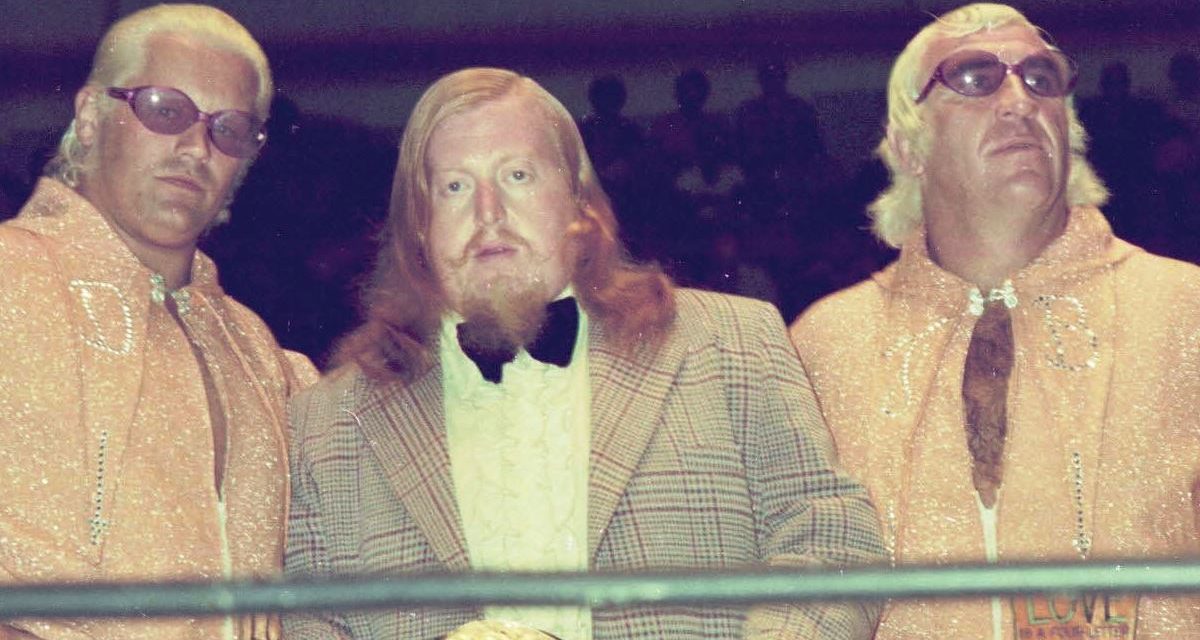Sir Oliver Humperdink was among the many that wondered whatever happened to Jerry Brown, whom he managed in the great ’70s team The Hollywood Blonds, with Buddy Roberts. He hadn’t seen him since the early ’80s, and had heard all kinds of tales about his whereabouts and misdeeds.
Then one evening, at a Harley Race-promoted wrestling show in Waterloo, Iowa, coinciding with the George Tragos/Lou Thesz Professional Wrestling Hall of Fame induction weekend, Humperdink got an unexpected surprise.
“I’m at the show that night and I’m down on the floor talking to Harley or Larry Hennig or somebody,” said Humperdink. “He comes up behind me and taps me on the shoulder. I turn around and look, and it was Jerry Brown. He had no idea that I was going to be there, and of course I had no idea he was going to be there. I almost didn’t go. The fact that he was there was a bolt out of the blue.”
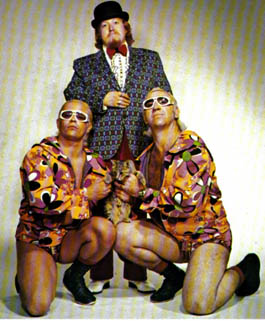
The Hollywood Blonds — Buddy Roberts, Sir Oliver Humperdink, and Jerry Brown — in a 1973 Grand Prix Wrestling promotional photo.
Brown, who lives in Tulsa, Oklahoma, was in Waterloo staying with a friend for a class reunion. That friend happened to have an extra ticket for the World League Wrestling show, and convinced the reluctant old mat star to go.
Now out of hiding — “It wasn’t no secret,” he insisted — Brown laughed at how it all came about, especially freaking out his old manager. “His eyes got as big as saucers!”
SOH admits that it threw him for a loop. “I looked at him for a second,” he said. “He was the last person I expected to see. I looked at him, I looked at him. It took maybe three or four seconds. I said, ‘Jerry Brown.’ I could not believe it. It was just so surreal, the whole thing was so surreal, I just couldn’t believe it.”
Now a little more in the loop in regards to some old friends and co-workers, Brown is considering heading out to some of the various reunions that are held around the country.
And the 73-year-old Brown took some time to revisit some of his wrestling career for SLAM! Wrestling.
Born Gerald Brown in Albert Lea, Minnesota, on May 10, 1937, he grew up on a farm. His mother died from a brain tumor when he was young, and the family uprooted, first to Iowa, where he did three days of Grade 9 and dropped out, then Kansas City, where he discovered professional wrestling.
Live wrestling shows were a weekly occurrence. “Every Thursday night in Kansas City, I went every Thursday night, I wouldn’t miss,” said Brown, who loved to watch Harley Race and Lou Thesz. “See, originally what I wanted to be was a baseball player, a pitcher. That’s what I wanted to be, but I got turned around and didn’t get there. So I seen them on TV one Saturday, I guess it was, and I got to watching it, and watching it, until I said, ‘Maybe I can do this.’ That’s where it all started.”
While working in construction, Brown started the slow process of breaking into a secretive business. He fell under the tutelage of Charlie Adcocks, and they worked out in a gym in Argentine, Kansas, just outside Kansas City.
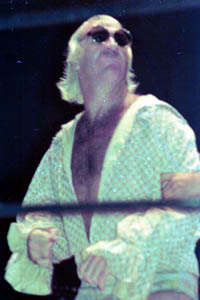
Jerry Brown struts his stuff. Photo courtesy Pete Lederberg, facebook.com/PeteLederbergsWrestlingPhotos
It came quickly to him, said Brown. “I don’t know why. I could take all the bumps, do all the holds, and everything, before I ever got in the ring with a professional wrestler. I knew it all,” he bragged. The early training was pretty simple. “The most things were how to come off the ropes, stuff like that. I knew probably everything else. If they gave me a back drop, I knew what I was going to do — I was going to land flat on my back.”
No one ever took him aside and explained that pro wrestling was a “work” and that cooperation was needed on both sides to make it look real. “After I got to working out and stuff, he’d show me things, and I realized what was going on. … I didn’t have to ask him about it; I could see. There wasn’t no asking about it that I needed.”
In his prime, Brown went at 230 pounds on his 6′ 1-1/4″ frame. “I never was into weights. I never had a body,” he explained. “I worked out with weights, but I didn’t work out heavy. I was more lean than bulky. I figured I could move better.” He was also into boxing, claiming a Kansas City Golden Gloves title. “I did that because the guy that had the gym, and he had a ring in there, he wouldn’t let me use the ring unless I boxed for him. So I did. That way I got to use the ring.”
Aside from Adcocks, another early influence was Bob Orton Sr. “He showed me a lot of things, and told me a lot of things about wrestling. In fact, he told me to stay out of wrestling!” Brown laughed. “I didn’t listen to him and went ahead and did it, and finally broke into wrestling.”
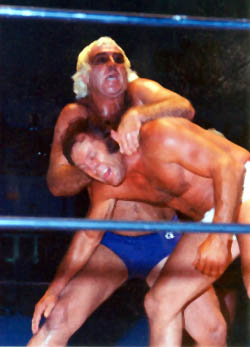
Jerry Brown has control of Danny Hodge. Photo courtesy Pete Lederberg, facebook.com/PeteLederbergsWrestlingPhotos
Bob Geigel was the promoter in Kansas City. He was reluctant to hire Brown, and took a while to come around. “We had to go, I don’t know how many times. It took me about four years to get into it, back and forth. I worked out at the gym and stuff. Finally, he gave me a break and I went to St. Joe to wrestle on TV one night.” That was Brown’s debut, and shortly thereafter, he was off to Oklahoma for Leroy McGuirk.
The next big influence for Jerry Brown was “Dandy” Jack Donovan. “He took me under his wing and showed me things,” Brown recalled. Donovan used his wife, Verne Bottoms, as a valet. “They took me as their tag team partner, but he told me I’d have to dye my hair. I’m looking, going, ‘Do I really want to do this?’ (laughs) I dyed my hair and then I never wanted to go outside where everybody was looking at me.”
The pre-Hollywood Blonds Jerry Brown had lots of confidence. “I had, I would say, not patting myself on the back or anything, but I had more talent than most of the guys that had been in the business that long,” he said. “I was just starting. It’s like a baseball player, or anybody else — they’re trying to get theirself together and find out who they are and where they’re at. That’s the way I was. I didn’t know what I was or what I was going to do, or how I was going to do this or that. Then when Watts came down and he took over, well, he put it together for us.”
But before Bill Watts could put The Hollywood Blonds together in the huge Oklahoma/Louisiana territory he had just taken over from McGuirk, something had to break. That was Donovan’s ankle.
The plan to have Donovan and Brown pushed as a team was dropped. Watts remembered a youngster from Vancouver that he’d met in the AWA, Dale Hey, and offered him the spot.
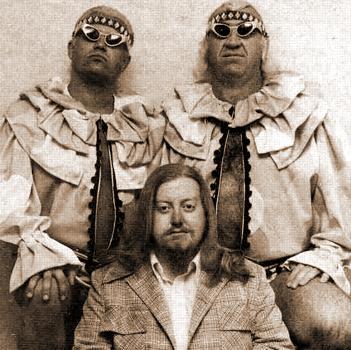
The Hollywood Blonds.
“[Watts] dyed my hair blonde and he got me to change my name to Buddy Roberts. He teamed me up with Jerry Brown as the Hollywood Blonds,” recalled Roberts.
They clicked from the get-go, and the Blonds, dressed in fancy ring jackets — made by Brown’s ex-wife — and wearing big sunglasses, would team from 1970 to 1977, a remarkably long run for the time.
“We got along real good,” Brown said of his partner, adding with a chuckle, “He was a Taurus and so was I.”
To keep his papers in order, Roberts, a Canadian citizen, had to return home periodically. Hence the Hollywood Blonds nearly taking over in Montreal, first in 1972, when they wrestled for the Rougeau’s Les As de la Lutte promotion, and the following year, when they returned, but this time having jumped to the rival Grand Prix Wrestling run by the Vachons.
Added to their act for the second go-round in Montreal was a young man named Red Sutton, who had been setting up the ring and carrying ring jackets in Minneapolis. It was his big break.
“They wanted to come back in ’73 with something different, and I was the something different,” said Humperdink. “Grand Prix Wrestling was running head to head with the Rougeau brothers. We worked for Grand Prix at the time. They wanted some difference. I was lucky enough to hook up with those guys right in the main events right from the get-go. It was really exciting and a great time in my life. I really enjoyed it with those guys.”
“He fit in right away,” said Brown about his former manager. “Have you seen, Humperdink? He’s a friend of mine, a real good friend. But Humperdink is one of those people that automatically get heat.”
The Montreal crowds were intense, said Brown. “I loved it, because they’re a little bit hot-natured. … It was just fun to be around. We acted like we were queers — you know that. It got so bad in Montreal that Buddy, heh heh, he’d get into the taxi, and snuggle up to the driver; it got so bad we couldn’t catch a ride in Montreal.”
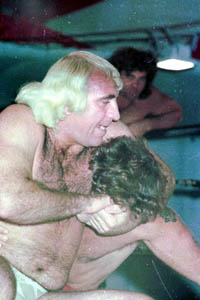
Jerry Brown clamps on a headlock. Photo courtesy Pete Lederberg, facebook.com/PeteLederbergsWrestlingPhotos
They tried to live the gimmick. “One time we went to the hockey game. We walked in the building, and when we walked in that building, we were going up the stairs, and that building went dead silent. They’d seen us, and they started booing. They stopped the hockey game and we had to get out of there because they couldn’t play the game. … We went out to the car, and when we got out to the car, there were a bunch of people there. When we finally got in the car, they tried to tip the car over on us.”
Up next, the Blonds went to Florida in ’74.
“They didn’t use us right there,” said Brown, explaining that the promoter, Eddie Graham “tried to keep us down, underneath and stuff. They wouldn’t let us have any main events because his boy was there and he’d get all the top shots.”
They went west in 1975 to Los Angeles. “It was good, I can’t say it wasn’t good, it was good there for us. We were there for a while,” said Brown. “It wasn’t the best money. It was fair money. We wanted to go out there and see what was happening.”
They did a handful of trips to Japan as well. The schedule there wasn’t ideal, said Brown.
“That was hard, that was a hard trip. Buddy, he (laughs), you’ve got to know Buddy. He don’t like getting up early in the morning, he usually likes to sleep until 1, 2 o’clock in the afternoon. If we had to get up in the morning, he would take it out on somebody through the day.”
Back in Oklahoma, the team called it quits in 1977. Roberts would work single then he would find his greatest fame as one of the Fabulous Freebirds. Humperdink would manage many, many other stars.
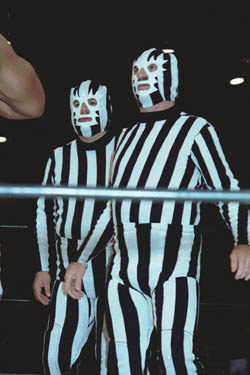
The Alabama Chain Gang. Photo courtesy Pete Lederberg, facebook.com/PeteLederbergsWrestlingPhotos
Brown settled down, traveled less. He teamed with Ron McFarlane for a while, including under masks in Florida as the Alabama Chain Gang. They wore full body suits with black and white stripes, and masks to match. It was difficult to work under the outfits, said Brown.
He also went to Puerto Rico numerous times, with Bobby Jaggers as his partner. “Boy, that was a place, phew. They had a fence around the ring, so they couldn’t get to us. We were wrestling there one night and a big 2×4 came into the ring with spikes in it, and stuck right in the middle of the ring,” he remembered. “We couldn’t get out of the buildings, there were so many people out front trying to get to us.”
By 1981 or so, he couldn’t do it anymore. “For the last year, I didn’t want to put my shoes on, I didn’t want to put my boots on. I hated it,” he said. “In other words, I got burned out on it.”
A brief attempt at promoting in Iowa shortly thereafter was mainly an effort to let two of his sons learn to wrestle. After wrestling, he worked as a bouncer until graduating into being a bartender, helping to run a bar.
Despite what the rumor mill has churned over the years, he was never in trouble with the law. “I can tell you this, I never was in prison, I never was on dope, and I never got arrested for dope or anything like that.”
Today, Brown takes it easy, with his two dogs. “I’m retired, and I’m not doing nothing,” he said. “I’m bored to death.” He likes to fish, but “You can only do so much fishing,” and travels a lot in his RV.
